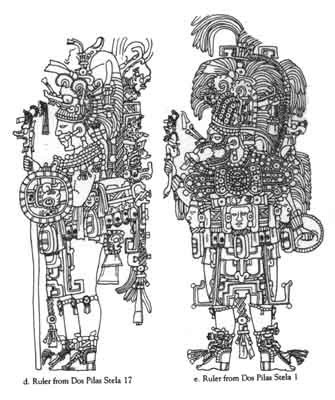
| From The Blood of Kings by Linda Schele and Mary Ellen Miller Plate 2 A ruler dressed as Chac Xib-Chac and the Holmul Dancer Late Classic period, A.D. 600-800 Ceramic with traces of red, orange, and blue pigments 23.8 x 9.9 x 9.8 cm Kimbell Art Museum, Fort Worth This extraordinary clay figurine depicts a Classic period king with such presence and detail that one might expect it to be a much larger sculpture. The king is dressed in very special regalia associated with war and the ritual of bloodletting; this regalia is also identified on images of kings at Palenque and Dos Pilas. The zoomorphic headdress sits above a headband made of jade cylinders and yellow beads. Behind the redeyed zoomorph, a huge fan of long blue feathers with red outlines forms a framing arc around the king's head. Yellow shapes rise diagonally from the upper corners of the zoomorph's head, then fall downward to round disk shaped motifs identified with the bloodletting rite. They are disks with cloth knots attached. The zoomorph in the headdress has yellowbanded blue shells as earflares and a yellow diadem atop its head. He is ChacXibChac, a god associated with war, sacrifice, dancing and fishing scenes. The king's red-painted face is flanked by blue earflares; a rare rectangular mouthpiece, painted yellow, is suspended around his mouth. Such a mouthpiece is also depicted on the stucco figures in Pacal's tomb at Palenque and on Dos Pilas Stela 17. The actual artifact, made of thin pieces of pyrite covered with redpainted plaster, was found near Pacal's skull in the Temple of Inscriptions. The rest of the figurine's costume is standard for Maya rulers; it is identical to costumes worn by rulers on Dos Pilas Stelae I and 17. Here, a large round pectoral with triple loops decorating both ends covers the king's chest. From other examples, especially the Tablet of Creation of Palenque, we know this pectoral to have been a special knot tied from groups of thin twine. When it is worn, the king always appears in the costume of one of several gods, including Chac.XibChac, the Paddler Twins from the canoe scenes at Tikal or the Palenque Triad. Here, the king wears Chac,XibChac in his headdress. Below the knot pectoral, he wears a second one a bar carved in the form of a skull, with three cylinders attached to each end. This skull pectoral is normally worn when the king is dressed as a warrior and plans to take captives. The same two pectorals are worn by Shield God K, the ruler on Dos Pilas Stela 1 * The king wears a heavy, wide, double-banded blue belt that signals his kingship and rank.Three blue heads, each with blue celtshaped objects hanging below them and a red knot draped above them, are mounted on the belt, and a double strand of yellow shells hangs below. This representation of the royal belt is the only one to have survived from the Classic period with its color intact. Under the belt, the king wears a stiff, kneelength apron. The painted imagery on the front of the apron can be recognized as the standard apron designGod C with the Squarenosed Serpent fret framing each side. Here God C's tooth hangs below the bottom edge, defining the blank between the serpent frets as the mouth. This apron represents the World Tree, rendered so that its bent branches parallel the God C image on the trunk, and it symbolizes that the king is the axis mundi, the central axis of the Maya world. The king's costume is completed with knee ornaments and highbacked sandals with conical ornaments tied to the front. Except for the headdress zoomorph, this king's dress is identical to Flint Sky God K on Dos Pilas Stela 17. Like that ruler, he probably once held a God K scepter in his right hand to balance the round shield in his left. The Dos Pilas ruler wears the same mouthpiece, and the manner in which the belt extends well beyond & back is similar in both costumes. The Dos Pilas belt supports the backrack of the Holmul Dancer, which has the Waterlily Jaguar, who is often paired with ChacXibChac, sitting within a skyband. This backrack is missing on the figurine, but two holes are drilled into the top of the belt (Pl. 2a). A Holmul Dancer backrack, perhaps resplendent with real feathers, was once thrust into these holes. The Dos Pilas monuments suggest the date of this figurine and the ritual in which the king acts. Stela 17 is dated to 9.12.10.0.0 9 Ahau 18 Zotz', or May 10, A.D. 682, and shows Flint Sky God K, while Stela I shows his son Shield God K on 9.13.15.0.0 13 Ahau 18 Pax, or December 31, A.D. 706. The figurine may date from approximately this period, but evidence of costume is inconclusive support for the Dos Pilas region as its source. It is, however, indicative of a particular ritual, and since both Dos Pilas dates are period endings, the costume must be associated with ceremonies conducted on those occasions. Since some of his costume's elements occur with war scenes, we deduce that the king is dressed in his role as warrior, either in preparation for taking captives or for offering captives as sacrificial victims at the period ending rites. |
||||
 |
||||